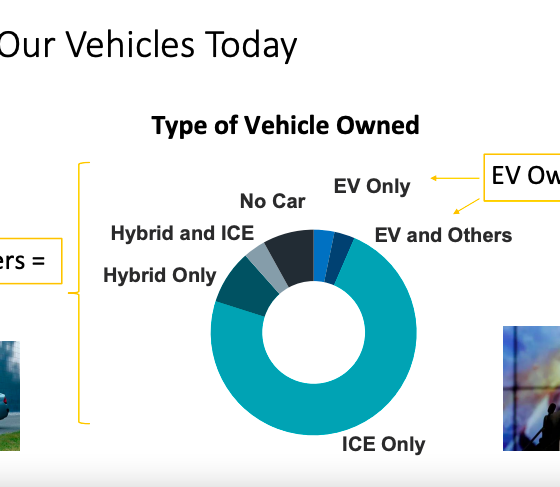A new study shows that only 26% of U.S. households are familiar with EVs but this is about to change. In the recent study by Parks Associates, it was noted that as Tesla became a household name, purchase intention for EVs has gone up 6%.
I wrote about this here, and Teslarati was invited to attend to the virtual session where Chris White, the senior analyst who conducted the study, led a virtual presentation.
According to the study,
“Only 26% of US broadband households report high familiarity with electric vehicles but that’s about to change. These sessions address the coming surge of EVs on the market, the potentially explosive EV growth in adoption, and the implications for consumers, the grid, and needed infrastructure.”
Electric Vehicles: A New Era for Consumers
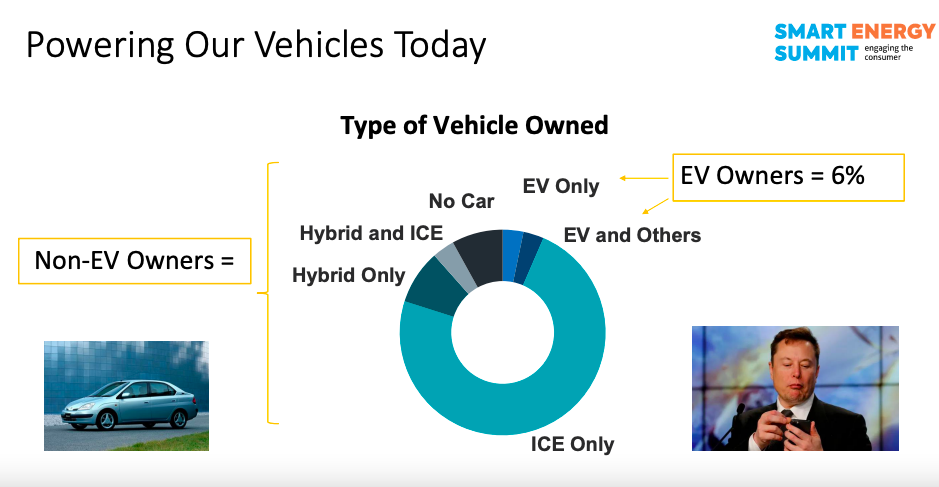
During the virtual session, Chris White explained some of the findings of the study. Some of these include current EV owner demographics, EV owner interest in clean energy, EV owners’ high-tech affinity, lack of knowledge of EV features, and how other issues such as the chip shortage are affecting both EV and non-EV markets.
The report was based on data from Q4 2021.
Understanding Current EV Owners
Current EV owners are young affluent and have dual incomes. Many are from a multifamily environment and use their EVs for work and school.
They use their vehicles regularly. It’s important to highlight since EVs have the image of a rare or exotic car that doesn’t have enough range. This is changing.
As the EV market continues to grow, the demographics of the current EV owners will most likely change. For now, there’s a 16% high intention of purchasing EVs among non-owners. Previous that was 10%.
That number didn’t include the current EV owners who either want to add a new EV or replace an old one.
EV Owners 3x likely to use renewable energy
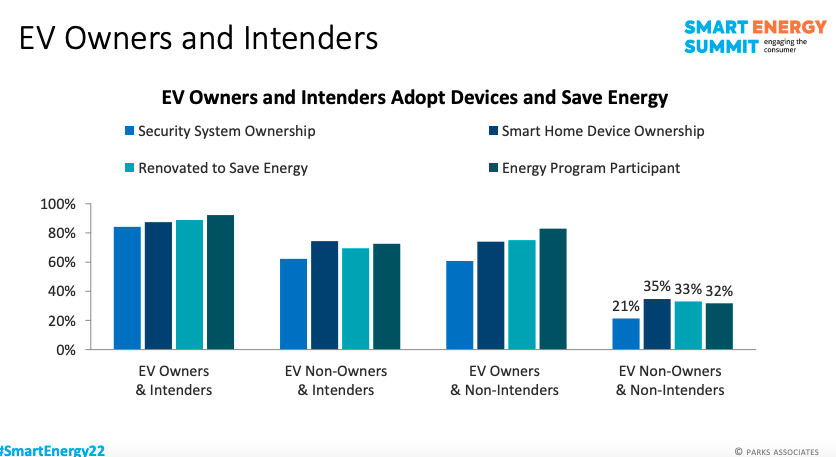
Chris White’s research showed that EV buyers are three times more likely to live in solar communities or have an interest in renewable energy powering their homes. They are also 2.5 to 5 times more willing to pay more for renewable energy.
The research shows that EV owners care about their carbon footprint and the impact on the environment.
EV owners are much more likely to own a security system or a smart home device than non-EV owners, according to the research
They xcare about technology and have a higher affinity for tech than non-EV owners.
Lack of familiarity with EV features.
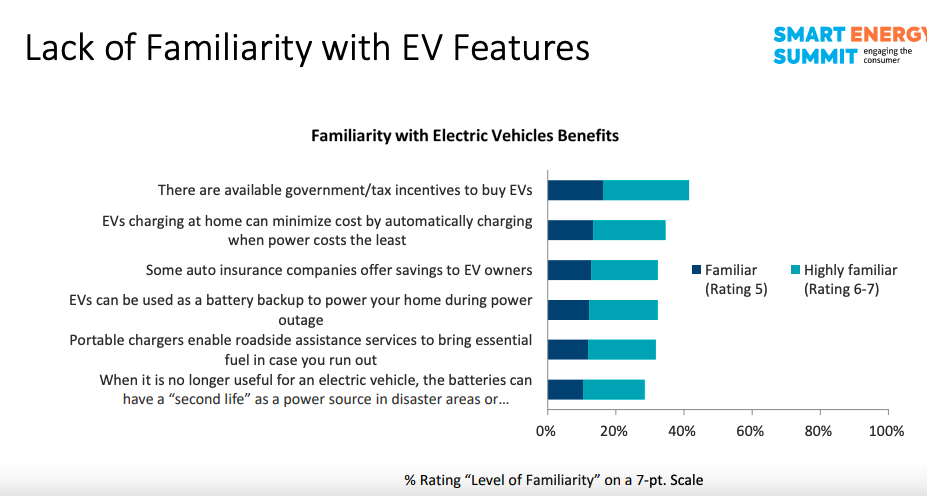
One of the key points in the study shows that although EVs are more popular today, there is a lack of familiarity with their features.
Chris pointed out that 18% of the consumers polled indicated familiarity with EV features. That isn’t a lot.
Features that many aren’t familiar with include EV charging at home minimizing cost when automatically charging during off-peak hours, auto insurance savings for EV owners, second-life EV batteries reused as a power source in disaster areas, and available tax incentives.
Second-life EV batteries are expected to reach over $34 billion by 2027 according to Research and Markets. You can read more about this here.
EV Features that could persuade non-owners to buy an EV
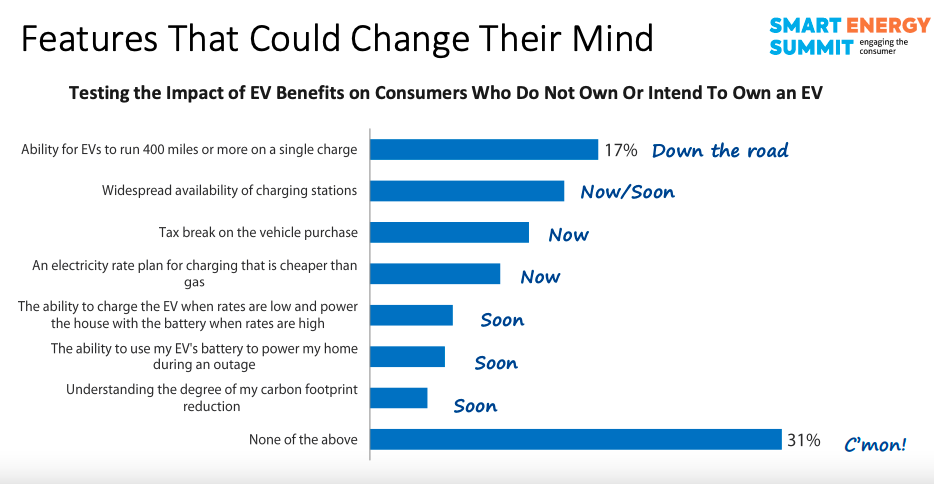
The study included the top features that could persuade non-EV owners to switch to electricity. The number one feature was for an EV to run 400 miles or longer on a single charge.
During the session, Chris pointed out that this is still rare and that most EVs are in the 200-300 mile range.
Other features included widespread charging stations and electricity plans that make owning an EV more affordable than owning an ICE vehicle. These are coming and soon people will see for themselves that EVs meet the criteria they are looking for.
Purchase Inhibitors.
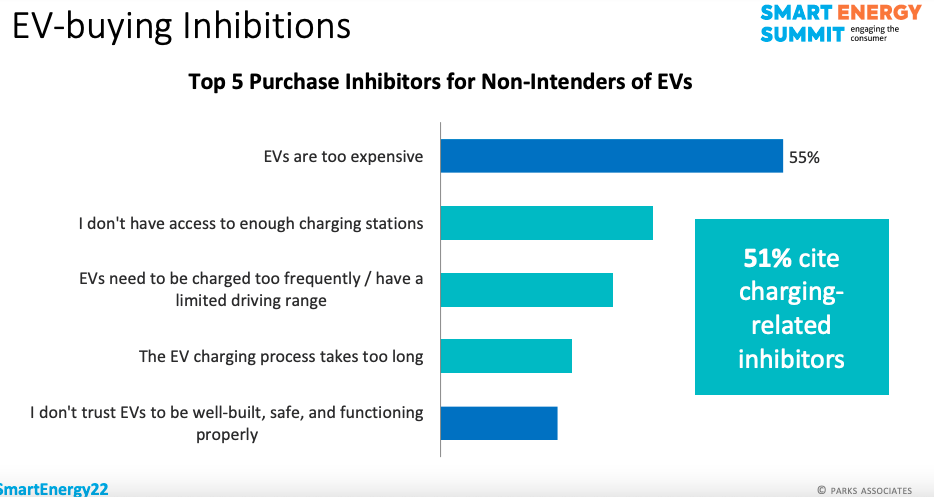
The number one purchase inhibitor that non-EV owners are concerned about are the cost of an EV and charging.
The research showed that 51% of the consumers who participated in the study cited charging-related issues.
Another issue was the lack of trust in the design of EVs,
Issues that impact both EV and non-EV purchases
We often see issues such as the semiconductor chip shortage and critical minerals for EV batteries impacting the EV market. However, something that impacts both markets includes the chip shortage, Putin invading Ukraine, and the national gas prices being on the rise.
The latter can create pain at the pump which is something that encourages people to make the switch to EVs. Last month, I wrote about Dobson who purchased a Tesla due to several factors but especially high gas prices.
EVs will be everywhere soon.
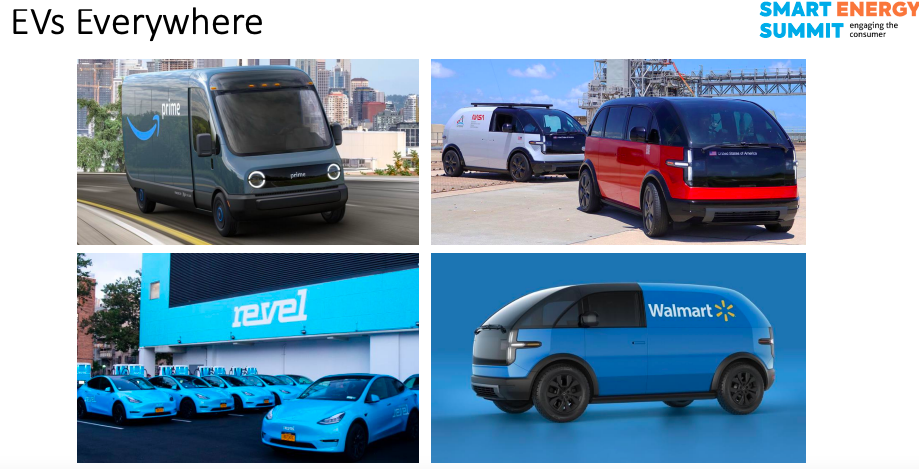
The research also revealed that soon, EVs will be everywhere.
Chris spoke about the Amazon and Rivian partnership, Walmart’s purchase of Canoo EVs, Revel’s fleet of Tesla taxis in New York, and the contract between NASA and Canoo.
And this is just on the commercial side. Other automakers are producing and marketing their own EVs to compete with Tesla.
Disclaimer: Johnna is long Tesla.
I’d love to hear from you! If you have any comments, concerns, or see a typo, you can email me at johnna@teslarati.com. You can also reach me on Twitter @JohnnaCrider1

Elon Musk
Elon Musk and Tesla AI Director share insights after empty driver seat Robotaxi rides
The executives’ unoccupied tests hint at the rapid progress of Tesla’s unsupervised Robotaxi efforts.
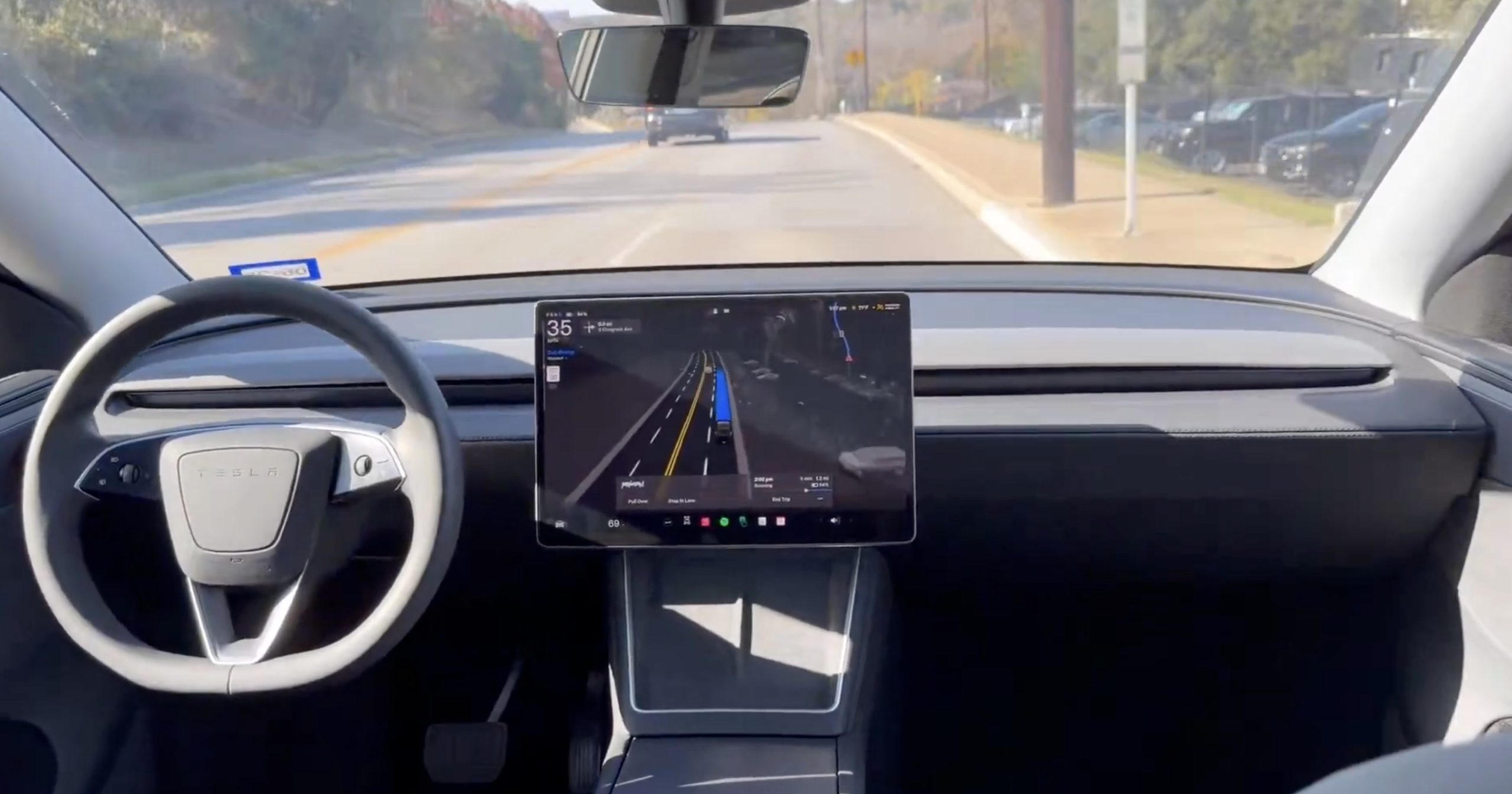
Tesla CEO Elon Musk and AI Director Ashok Elluswamy celebrated Christmas Eve by sharing personal experiences with Robotaxi vehicles that had no safety monitor or occupant in the driver’s seat. Musk described the system’s “perfect driving” around Austin, while Elluswamy posted video from the back seat, calling it “an amazing experience.”
The executives’ unoccupied tests hint at the rapid progress of Tesla’s unsupervised Robotaxi efforts.
Elon and Ashok’s firsthand Robotaxi insights
Prior to Musk and the Tesla AI Director’s posts, sightings of unmanned Teslas navigating public roads were widely shared on social media. One such vehicle was spotted in Austin, Texas, which Elon Musk acknowleged by stating that “Testing is underway with no occupants in the car.”
Based on his Christmas Eve post, Musk seemed to have tested an unmanned Tesla himself. “A Tesla with no safety monitor in the car and me sitting in the passenger seat took me all around Austin on Sunday with perfect driving,” Musk wrote in his post.
Elluswamy responded with a 2-minute video showing himself in the rear of an unmanned Tesla. The video featured the vehicle’s empty front seats, as well as its smooth handling through real-world traffic. He captioned his video with the words, “It’s an amazing experience!”
Towards Unsupervised operations
During an xAI Hackathon earlier this month, Elon Musk mentioned that Tesla owed be removing Safety Monitors from its Robotaxis in Austin in just three weeks. “Unsupervised is pretty much solved at this point. So there will be Tesla Robotaxis operating in Austin with no one in them. Not even anyone in the passenger seat in about three weeks,” he said. Musk echoed similar estimates at the 2025 Annual Shareholder Meeting and the Q3 2025 earnings call.
Considering the insights that were posted Musk and Elluswamy, it does appear that Tesla is working hard towards operating its Robotaxis with no safety monitors. This is quite impressive considering that the service was launched just earlier this year.
Elon Musk
Starlink passes 9 million active customers just weeks after hitting 8 million
The milestone highlights the accelerating growth of Starlink, which has now been adding over 20,000 new users per day.

SpaceX’s Starlink satellite internet service has continued its rapid global expansion, surpassing 9 million active customers just weeks after crossing the 8 million mark.
The milestone highlights the accelerating growth of Starlink, which has now been adding over 20,000 new users per day.
9 million customers
In a post on X, SpaceX stated that Starlink now serves over 9 million active users across 155 countries, territories, and markets. The company reached 8 million customers in early November, meaning it added roughly 1 million subscribers in under seven weeks, or about 21,275 new users on average per day.
“Starlink is connecting more than 9M active customers with high-speed internet across 155 countries, territories, and many other markets,” Starlink wrote in a post on its official X account. SpaceX President Gwynne Shotwell also celebrated the milestone on X. “A huge thank you to all of our customers and congrats to the Starlink team for such an incredible product,” she wrote.
That growth rate reflects both rising demand for broadband in underserved regions and Starlink’s expanding satellite constellation, which now includes more than 9,000 low-Earth-orbit satellites designed to deliver high-speed, low-latency internet worldwide.
Starlink’s momentum
Starlink’s momentum has been building up. SpaceX reported 4.6 million Starlink customers in December 2024, followed by 7 million by August 2025, and 8 million customers in November. Independent data also suggests Starlink usage is rising sharply, with Cloudflare reporting that global web traffic from Starlink users more than doubled in 2025, as noted in an Insider report.
Starlink’s momentum is increasingly tied to SpaceX’s broader financial outlook. Elon Musk has said the satellite network is “by far” the company’s largest revenue driver, and reports suggest SpaceX may be positioning itself for an initial public offering as soon as next year, with valuations estimated as high as $1.5 trillion. Musk has also suggested in the past that Starlink could have its own IPO in the future.
News
NVIDIA Director of Robotics: Tesla FSD v14 is the first AI to pass the “Physical Turing Test”
After testing FSD v14, Fan stated that his experience with FSD felt magical at first, but it soon started to feel like a routine.

NVIDIA Director of Robotics Jim Fan has praised Tesla’s Full Self-Driving (Supervised) v14 as the first AI to pass what he described as a “Physical Turing Test.”
After testing FSD v14, Fan stated that his experience with FSD felt magical at first, but it soon started to feel like a routine. And just like smartphones today, removing it now would “actively hurt.”
Jim Fan’s hands-on FSD v14 impressions
Fan, a leading researcher in embodied AI who is currently solving Physical AI at NVIDIA and spearheading the company’s Project GR00T initiative, noted that he actually was late to the Tesla game. He was, however, one of the first to try out FSD v14.
“I was very late to own a Tesla but among the earliest to try out FSD v14. It’s perhaps the first time I experience an AI that passes the Physical Turing Test: after a long day at work, you press a button, lay back, and couldn’t tell if a neural net or a human drove you home,” Fan wrote in a post on X.
Fan added: “Despite knowing exactly how robot learning works, I still find it magical watching the steering wheel turn by itself. First it feels surreal, next it becomes routine. Then, like the smartphone, taking it away actively hurts. This is how humanity gets rewired and glued to god-like technologies.”
The Physical Turing Test
The original Turing Test was conceived by Alan Turing in 1950, and it was aimed at determining if a machine could exhibit behavior that is equivalent to or indistinguishable from a human. By focusing on text-based conversations, the original Turing Test set a high bar for natural language processing and machine learning.
This test has been passed by today’s large language models. However, the capability to converse in a humanlike manner is a completely different challenge from performing real-world problem-solving or physical interactions. Thus, Fan introduced the Physical Turing Test, which challenges AI systems to demonstrate intelligence through physical actions.
Based on Fan’s comments, Tesla has demonstrated these intelligent physical actions with FSD v14. Elon Musk agreed with the NVIDIA executive, stating in a post on X that with FSD v14, “you can sense the sentience maturing.” Musk also praised Tesla AI, calling it the best “real-world AI” today.
